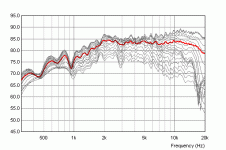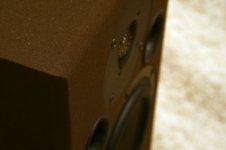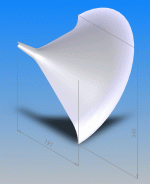Normally, what I do is when anyone presents listening impressions pointing out quite specific aspects, I look at data, see what can be improved, do the improvement, look at the new data, then listen to see if previous difficiencies are improved or not. After doing this for a few hundred rounds, one generally gets a good feeling how certain listening impressions relate with what data.Ok, I won't "snip" anything off this one.
So then you do admit that without the CSD data it was a complete guess with nothing to substantiate it? I think that this is the kind of thing that I and others find annoying in many of the posts here - completely unfounded claims and suggestions that would be better left unsaid.
My appology if people found the "tone" was "condescending", but somewhere along the line someone needs to say something about the unsubstantiated claims, generalizations and total guesses that people pass off as "data". This thread carries my name, so maybe that makes the "rational police".
This is very common in development of technology in any field. Find something that seems like a problem, figure out ways to reliably detect what might be wrong, then generate a means to reliably predict and avoic such problems to result in the desired performance.
Soongsc
A very thorough and complete procedure. I wish that everyone would be so dilligent.
"I look at data" - and the "data" that you looked at when you made the comment "My guess would be loading problem." was what again? Also, could you explain what exactly a "loading problem" is?
I mean I've built and listened to a few waveguide systems before and I would not have jumped to such a conclusion. In fact I had no idea what it was you were refering to.
I'm sorry to give you such a hard time, I'm not trying to be a "pain", but you really do have to put a little more analysis behind some of the statements that you make.
A very thorough and complete procedure. I wish that everyone would be so dilligent.
"I look at data" - and the "data" that you looked at when you made the comment "My guess would be loading problem." was what again? Also, could you explain what exactly a "loading problem" is?
I mean I've built and listened to a few waveguide systems before and I would not have jumped to such a conclusion. In fact I had no idea what it was you were refering to.
I'm sorry to give you such a hard time, I'm not trying to be a "pain", but you really do have to put a little more analysis behind some of the statements that you make.
Be patient. They promised measurements within 3 days when horns will come back from Gelsenkirchen. How does toe-in helps with imaging? Here problem is that if you move from center position sound shifts to the right or to the left.
It seems you don't look at CSD data, so I really don't know what to say. I try to look at as much data that I can get. As a matter of fact, I also send things out to other labs that have capability that I don't have. I really don't show ALL data that I look at, but it seems on most subjects discussed here, I have probably posted more data than anyone else. I can't gather data for this particular case because I don't have this particular speaker in question, but if the CSD data can be posted with the same resolution that I have posted on other issues, the discussion would be much more meaningful. I'm not afraid of being wrong.
I'm going to let Earl respond to this one and see what analysis or data shows up.😉Be patient. They promised measurements within 3 days when horns will come back from Gelsenkirchen. How does toe-in helps with imaging? Here problem is that if you move from center position sound shifts to the right or to the left.
Be patient. They promised measurements within 3 days when horns will come back from Gelsenkirchen. How does toe-in helps with imaging? Here problem is that if you move from center position sound shifts to the right or to the left.
Toe-in only helps if the speakers are CD. Those speakers that you have shown are unlikely to be CD.
I'm not afraid of being wrong.
That's evident.
Those speakers that you have shown are unlikely to be CD.
Why? Do you bet with me 🙂
Why? Do you bet with me 🙂
That would be a pointless endeavor because there is no concrete deffinition of CD. But perhaps I am under a misconception. I thought those horns had a Leclerq contour and that contour is well know to not be CD. Looking back at the photos, its impossible to tell what the contour is. In my experince only an OS waveguide will be CD out to the highest frequencies - well at least as CD as is possible. Nothing is ever really truely CD and thats why a "bet" isn't possible because once it gets "grey" who decides?
I would be very interested in a full set of measurements, but that again is problematic because there is no "standard" on what "a full set of measurments" means.
If I could suggest, I would like to see the polar responses from the axis out to 90 degrees in 7.5 degree (or less) increments. Sorry 10 or 15 degrees is too coarse. The data can be smoothed, but no more than 1/6 octave. A full set of data taken with HolmImpulse would be great! Impulse responses every 7.5 degrees, export 8500 data points (-200 to 8300) to a single file and post that. Then we can all see the performance in a manner completely consistant with what I post for my speakers.
We need to see the full system, not just the waveguide. If you want to take some vertical polars would be good as well, but I'll understand if those are difficult to do as I have difficulty with this as well. I can, and do, take verticals +- 15 degrees, but thats all I can get from my setup.
Don't know if the have a twister for that monster. Simu says it is CD. Distance at least 2 meters? Here's my measurement on Seas tweeter, 5 deg step. Is it ok?
5 degrees does tend to be a little dense as your plot shows. I find 7.5 to be about right, but I'd prefer 5 degrees to 10 degrees. Scale should be no greater than 50 dB. And a full system plot, not just the tweeter, is necessary to draw any opinions from.
Hello,
http://www.diyaudio.com/forums/atta...258814376-geddes-waveguides-gelsenkirchen.jpg
For such mouth diameter Le Cléac'h horns are deeper (at least if T <1).
For what it seems to me this horn/waveguide is the result of a strange genome coupling between an OSwaveguide at the throat and a Le Cléac'h horn at the mouth.
I don't want to see this called a Gedlec! (Please! 🙄)
Best regards from Paris, France
Jean-Michel Le Cléac'h
http://www.diyaudio.com/forums/atta...258814376-geddes-waveguides-gelsenkirchen.jpg
For such mouth diameter Le Cléac'h horns are deeper (at least if T <1).
For what it seems to me this horn/waveguide is the result of a strange genome coupling between an OSwaveguide at the throat and a Le Cléac'h horn at the mouth.
I don't want to see this called a Gedlec! (Please! 🙄)
Best regards from Paris, France
Jean-Michel Le Cléac'h
I thought those horns had a Leclerq contour and that contour is well know to not be CD. Looking back at the photos, its impossible to tell what the contour is.
Min Phase Horn
Ui, ui ui calm down guys!
The discussion point of "constant directivity" or "true constant directivity" is a widely mute one as I also pointed out in my paper:
Dipole Horn, Dipole Directivity Control Device
Hence I call my designs "min phase" horns – to clearly state where they are heading (rather than how perfectly they meet the goal)!
No "Gedlec" nor "Leclerq" nor " Le Lee" or whatever malapropism – please do me a favour and stay with the name *I* gave it for some good reason – its simply a "Min Phase Horn" .
#########
You are right Jean-Michel – its not exactly a LeCleach contour.
Though I use your contour (and subsequent philosophy about wave front propagation) as a basis for my calculation due to their inherent consistency and smoothness that shows up in any directivity sonogram I've done so far – and no – there definitely is *no* oblade spheroide mixed in.
Its a grain of *Gaussian* ingredient I use.
🙂
#########
Yes. I have done simus for that very contour - but I will not share for the simple reason that no one knows what *exactly* the wave front shape is, that's injected into a horn's throat.
The flare of the compression driver exactly tells us *nothing* in this context – a rough guess at best...
And no – Earl – I wouldn't even trust your measurements you claim to have done in this department, as you clearly have failed to stay clear about the nature of wave fronts in general.
###########
So, I'd also suggest to patiently await measurements and hope for someone to have the time and guts to find out what's needed to let min phase contour shine.
###########
Anyone who can say something to the driver used ? – haven't found that much about the 2" Faital, except that FR looks fine IMO....
http://www.faitalpro.com/products/schede/cd.php?id=502030100
Michael
..
Those speakers that you have shown are unlikely to be CD.
...
Why? Do you bet with me 🙂
That would be a pointless endeavor because there is no concrete deffinition of CD. But perhaps I am under a misconception. I thought those horns had a Leclerq contour and that contour is well know to not be CD. Looking back at the photos, its impossible to tell what the contour is. In my experince only an OS waveguide will be CD out to the highest frequencies - well at least as CD as is possible. Nothing is ever really truely CD and thats why a "bet" isn't possible because once it gets "grey" who decides?
....
Hello,
....
For such mouth diameter Le Cléac'h horns are deeper (at least if T <1).
For what it seems to me this horn/waveguide is the result of a strange genome coupling between an OSwaveguide at the throat and a Le Cléac'h horn at the mouth.
I don't want to see this called a Gedlec! (Please! 🙄)
Best regards from Paris, France
Jean-Michel Le Cléac'h
Ui, ui ui calm down guys!
The discussion point of "constant directivity" or "true constant directivity" is a widely mute one as I also pointed out in my paper:
Dipole Horn, Dipole Directivity Control Device
Hence I call my designs "min phase" horns – to clearly state where they are heading (rather than how perfectly they meet the goal)!
No "Gedlec" nor "Leclerq" nor " Le Lee" or whatever malapropism – please do me a favour and stay with the name *I* gave it for some good reason – its simply a "Min Phase Horn" .
#########
You are right Jean-Michel – its not exactly a LeCleach contour.
Though I use your contour (and subsequent philosophy about wave front propagation) as a basis for my calculation due to their inherent consistency and smoothness that shows up in any directivity sonogram I've done so far – and no – there definitely is *no* oblade spheroide mixed in.
Its a grain of *Gaussian* ingredient I use.
🙂
#########
Yes. I have done simus for that very contour - but I will not share for the simple reason that no one knows what *exactly* the wave front shape is, that's injected into a horn's throat.
The flare of the compression driver exactly tells us *nothing* in this context – a rough guess at best...
And no – Earl – I wouldn't even trust your measurements you claim to have done in this department, as you clearly have failed to stay clear about the nature of wave fronts in general.
###########
So, I'd also suggest to patiently await measurements and hope for someone to have the time and guts to find out what's needed to let min phase contour shine.
###########
Anyone who can say something to the driver used ? – haven't found that much about the 2" Faital, except that FR looks fine IMO....
http://www.faitalpro.com/products/schede/cd.php?id=502030100
An externally hosted image should be here but it was not working when we last tested it.
Michael
Last edited:
According to audiophile experience, toeing the speakers always helps in creating better focus, but then it comes ro preferences whether they like better feel of "filling the room" or the "better focus". This is where audiophiles get mixed up because if the system does not have the capability to reveal original background timbre, then they might shift to recreating it using room treatment techniques, thus further losing focus and detail.Be patient. They promised measurements within 3 days when horns will come back from Gelsenkirchen. How does toe-in helps with imaging? Here problem is that if you move from center position sound shifts to the right or to the left.
Come on, you can do better than that.Toe-in only helps if the speakers are CD. Those speakers that you have shown are unlikely to be CD.
...

This is not the measurements for the speakers addressed here is it?Don't know if the have a twister for that monster. Simu says it is CD. Distance at least 2 meters? Here's my measurement on Seas tweeter, 5 deg step. Is it ok?
http://www.diyaudio.com/forums/multi-way/103872-geddes-waveguides-355.html#post1988781
Yes but I think it is good to have reference point for comparison. Most hard domes employ some kind of "directivity plugs".
We are ready to ship 12" OS waveguides, one piece no more than ~90€ or ~130$.
Hello Jzagaja,
That looks very interesting! Could you post some pictures of an actual device? For which opening angle of the compression drives was the contour calculated?
- Home
- Loudspeakers
- Multi-Way
- Geddes on Waveguides


